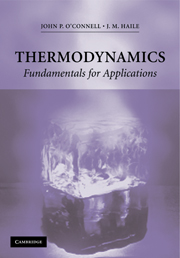Book contents
- Frontmatter
- Contents
- Preface
- Acknowledgments
- THERMODYNAMICS: Fundamental for Applications
- 0 Introduction
- PART I THE BASICS
- PART II SINGLE-PHASE SYSTEMS
- PART III MULTIPHASE AND REACTING SYSTEMS
- 7 Transfers, Transformations, and Equilibria
- 8 Criteria for Observability
- 9 Phase Diagrams for Real Systems
- PART IV ENGINEERING CALCULATIONS
- APPENDICES
- Notation
- Index
7 - Transfers, Transformations, and Equilibria
Published online by Cambridge University Press: 05 June 2012
- Frontmatter
- Contents
- Preface
- Acknowledgments
- THERMODYNAMICS: Fundamental for Applications
- 0 Introduction
- PART I THE BASICS
- PART II SINGLE-PHASE SYSTEMS
- PART III MULTIPHASE AND REACTING SYSTEMS
- 7 Transfers, Transformations, and Equilibria
- 8 Criteria for Observability
- 9 Phase Diagrams for Real Systems
- PART IV ENGINEERING CALCULATIONS
- APPENDICES
- Notation
- Index
Summary
When two or more homogeneous systems are brought into contact to form a single heterogeneous system, any of several actions may occur before equilibrium is reestablished. The possibilities include mass and energy transfers, chemical reactions, and the appearance or disappearance of phases. In this chapter we provide thermodynamic criteria for determining whether and to what extent such phenomena actually occur. Surprisingly, these criteria invoke no new thermodynamics—we need only combine familiar thermodynamic quantities in new ways and, in some cases, apply to those quantities mathematical operations that we have not used heretofore.
The heterogeneities of most concern to us are those that involve the presence of more than one phase. The analysis of multiphase systems can be important to the design and operation of many industrial processes, especially those in which multiple phases influence chemical reactions, heat transfer, or mixing. For example, phase-equilibrium calculations form the bases for many separation processes, including stagewise operations, such as distillation, solvent extraction, crystallization, and supercritical extraction, and rate-limited operations, such as membrane separations.
Analysis of multiphase systems is a principal theme of chemistry and chemical engineering; another is analysis of chemical reactions—processes in which chemical bonds are rearranged among species. Rearranging chemical bonds is the most efficient way to store and release energy, it drives many natural processes, and it is used industrially to make substitutes for, and concentrated forms of, natural products.
- Type
- Chapter
- Information
- ThermodynamicsFundamentals for Applications, pp. 256 - 309Publisher: Cambridge University PressPrint publication year: 2005



